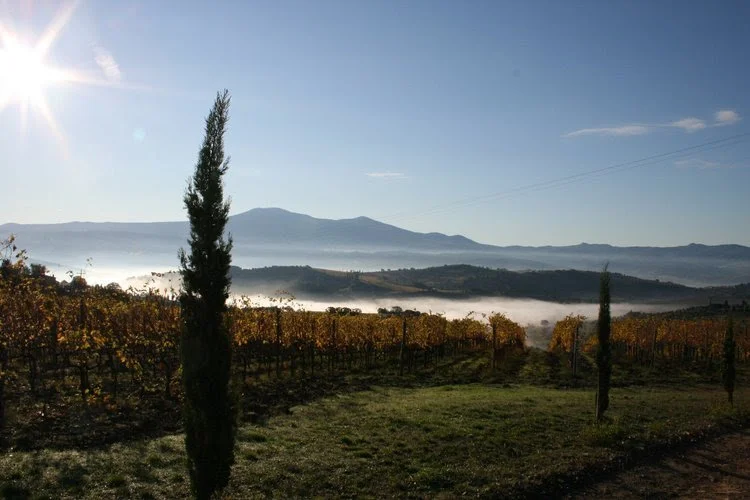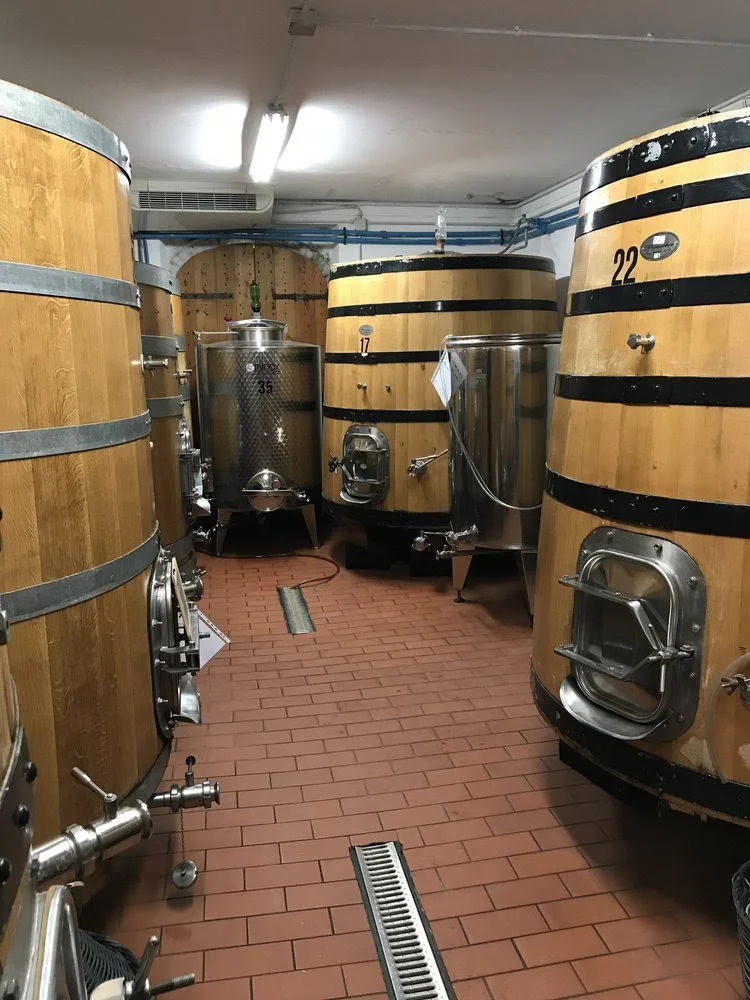San Polino -Brunello, ITaly
San Polino: Brunello for the Ages
AN INTRODUCTION
BRUNELLO DI MONTALCINO:
WHAT A LONG STRANGE TRIP IT’S BEEN
Sections of San Polino vineyard terroir:
limestone, shale, loam, seabed and volcanic remains.
One can argue the story of important parts of “Italian Wine” over the last several decades is ofttimes more reaction, than vision. Economics, recognition, fame, or the simple need of income and survival mark this history. The heralded wines of Brunello di Montalcino offer an example.
Fans of Chianti Classico, the great Tuscan neighbor appellation north of Brunello, know Chianti is from Sangiovese, as is Brunello… The same but different. Sangiovese: but, different clones + terroirs = different Sangiovese.
Brunello can be more bold and complex; a bigger “richer” wine. As for the appellation of “Brunello di Montalcino”, it only gained DOC status in 1968, and then DOCG status in 1980. Still “new”, Brunello’s reputation as one of the world’s great red wines is undisputed.
So: reaction vs. vision? How did some wineries go from cash poor and family run, to become among some of the more affluent in Tuscany? In part the answer in the 00’s was to create a wine supported, revered and endorsed by powerful sources (writers, magazines, books). Nothing unique for such a goal. If the price is higher, bills get paid and money can be made.
Some fifteen years ago, “Brunellogate” (documented in many places and in our now defunct E&R Wine Explorer back in 2008) brought to light a widespread (by production level), big time bending of the DOCG rules. “Brunello”, to qualify for the ever spendier name, had to be made of 100% Sangiovese grapes from the authorized zone.
For years, rumors blossomed of other grapes added from elsewhere.
How to make a wine taste like something it isn’t? Well, just add the right something it isn’t and see if you can get away with it. Some important producers did, and some got away with it for a time.
Why add other grapes? In this case, better press, higher scores and more awards (Italy is big on wine guides and awards - more so than any other country) raise demand and prices.
This U-Turn of acceptability, while not unique to Italian wine, is a significant factor in changing what some drinkers think Brunello is, or, over particular moments in time, should be.
Our mission has always been supporting well made wines that primarily reflect “the grape and the ground.” We have no interest in drinking something not based on what it truly ought to be, vs what it can be morphed into. We see our work is to objectively taste every wine we can; and yes, while tasting a wine is one thing, drinking a wine is another.
Allow us to introduce you to a new “almost direct imports” producer: San Polino of Montalcino.
San Polino’s Helichrysum vineyard.
“At San Polino we believe that all life on this planet is linked by a single thread, forming a myriad of wondrous interconnections which encompass all of us at San Polino: the people who work here, the animals, the plants, the insects, the people who come to visit us, our importers abroad and the people who buy and enjoy our wines wherever they may be in the world.
We hold that the qualities of balance, harmony, elegance and structure which make an aesthetic object of a wine are but the simple portrait of the balance, richness and harmony present in each of the ecosystems necessary for the production of that wine.
These ecosystems are dynamic, complex and exciting. At San Polino we wish to gain a deeper insight into how these ecosystems interplay and influence each other. We want to know their effects on the winemaking processes. That is why we invite research teams to the estate; geologists, botanists and entomologists, ornithologists and yeast experts. The better grasp we have of the complex natural world of the ecosystems in our vineyards, the better we can make our wines
At San Polino we believe that harmony in nature creates excellent wines.”
(-From Katia Nussbaum and husband Luigi Fabbro, founders of San Polino)
Older Slavonian oak.
SAN POLINO OF MONTALCINO
(Our interest in the wonderful wines from Katia and Luigi of San Polino, a few miles south of Montalcino, goes back to our eye-opening visit all the way back in October of 2018. Our memory for impressive wine, available or not, is long. We loved the wines, the work, the philosophy and the people: quite amazing actually. Though they had no wine to sell, we stayed vigilant in case that changed. Some five years later, it has.)
The San Polino team, guided principally by the earth, by their strong philosophy of organic farming, by a dynamic guidance for making wines as transparent as possible (allowing the grape and the ground to express themselves with no influence of wood, chemicals, tricks etc), are wedded to a non-interventionist MO in their winery and with their winemaking. From their farmstead dating back to the 10th century, since they began, they have never wavered with their 5 hectares of Sangiovese. If anything, they have doubled down on their mission - all that before, during and after Brunellogate.
Like the splendid wines of Baricci, these are singular wines. They are not necessarily what may be seen as some of the more mainstream examples these days: darker colored and at times influenced by oak and other factors outside the terroir. Taking your time with these wines will reveal a kind of wonder, one to be savored.
(We will soon add a full winery portrait of San Polino online. There is a lot to say about them.)
ALL WINES FEATURE SPECIAL INTRODUCTORY PRICES VIA THIS OFFER
TAKE AN ADDITIONAL 10% OFF ON ANY 6 OR MORE
(for in-store purchases only, either in-person or online)
Wines arrive today!
The helichrysum herb.
2021 Rosso di Montalcino
From San Polino’s Brunello terroir, their Rosso di Montalcino is bottled early to meet the DOC requirements of less aging before release. They could age it longer and sell at Brunello prices, opting instead to provide a rosso of greater value. Tiny production, chewy and structured, and as they point out “floral, fruity and happy.” Though happy perhaps is more what you will be vs what the wine itself is? $37.50
2017 Brunello di Montalcino
We’ve been sipping this one for the last twenty four hours and it gets two thumbs up from us all. Cliché maybe, but this wine is refined and real, it is being what it is. Another way to describe is as Jancis Robinson has: “Mid to deep ruby with orange tinges. A concentrated, earthy cherry nose that is almost a little rich with savoury, minerally, meaty notes. Lush cherry fruit with a full aromatic spread on the palate with tons of chewy tannins. Long and with lots of stuffing.” So enjoyable — and tasting very fine now. (3 cases only) $75.00
2017 Brunello di Montalcino “Helichrysum”
Only about 700 cases made, a wine of class and deserving some further aging. Between us and a variety of wine writers we respect, descriptions include “pressed roses, lavender, deep ruby with orange tinges, concentrated, savoury, meaty notes. tons of chewy tannins.” (2 cases only) $93.00
2015 Brunello di Montalcino Riserva
We were able to acquire a few cases from 2015 - easy to forget that is 8 years ago already! From the Wine Advocate “The San Polino 2015 Brunello di Montalcino Riserva (a 6,000-bottle release made with organic fruit) is another pretty protagonist from the vintage that does not hold back in terms of intensity, primary fruit character and dark plummy ripeness. Keeping in line with the characteristics of this warm and sunny vintage, this is a generous, soft and fruit-forward expression. Those 2015 tannins are a bit softer compared to 2016, and this wine is almost, but not quite, ready to drink straight out of the gate. For best results, however, give it another three years.94+” Don’t you miss this one. (3 cases only) $125.00






